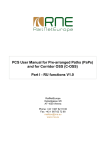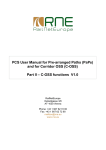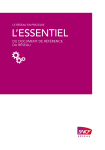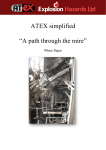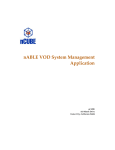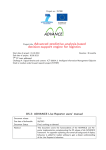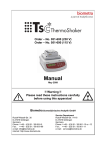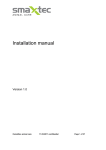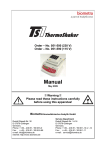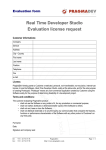Download PCS PROCESS GUIDELINES 2013 - Path Coordination System (PCS)
Transcript
PCS PROCESS GUIDELINES 2013 For path requests for the running timetable 2012 and the annual timetable 2013 Version: 1.0 / 09.12.2011 Updates Every alteration in this document is reported in the following list of alterations Nr. Date New (item, content) 1 03.01.2012 Dates amended in chapter 6 “Path Requests” RailNetEurope Oelzeltgasse 3/8 AT-1030 Vienna Phone: +43 1 907 62 72 00 Fax: +43 1 907 62 72 90 [email protected] www.rne.eu Notes PCS Process Guidelines 2013 Content 1. 2. 3. 4. 5. 6. 7. 8. 9. 10. 11. 12. 13. 14. 15. 16. 17. Set-up of PCS Introduction PCS process Open a dossier Path consulting / Feasability study Path request Path elaboration Draft timetable / Path offer Observations / Acceptance Post-processing Final offer Active timetable Deadline & Milestones PCS reference manual National path requests Support Remarks 3 3 4 4 5 5 6 6 6 7 7 8 8 10 10 11 11 2 PCS Process Guidelines 2013 1. SET-UP OF PCS Applicants can use PCS for all timetable phases. The date of submission of a path request to the Infrastructure Managers/Allocation Bodies (IMs/ABs) and the requested timetable period will decide if it is a path request placed in time for the next annual timetable, a late path request or an ad-hoc path request. 2. INTRODUCTION RailNetEurope (RNE) and its members will do their best to promote the use of PCS by companies applying for railway paths (hereafter: applicants). Path requests will be accepted via PCS and answers will be communicated through PCS either in addition to, or in replacement of, the traditional answering process already in use within the national organisations. The RNE Joint Office shall help applicants by providing them with functional and technical information (e.g. training, e-learning, providing access to PCS, interfaces, processes, guidelines). The use of PCS has to be made available to any applicant by any IMs/ABs for ad-hoc path requests for the running timetable 2012 and requests for the 2013 annual timetable. The process calendar for the timetable 2013 has been approved by RNE members and is valid both for passenger and freight path applications. PCS guidelines are applicable under the rules described in the RNE process handbooks for path allocation (documents are available on RNE website: www.rne.eu). These guidelines describe the main steps regarding international path requests which have to be fulfilled by applicants (either applicants or authorized applicants) requesting a path involving several IMs/ABs and by IMs/ABs itself. 3 PCS Process Guidelines 2013 3. PCS PROCESS Process steps for feasibility studies and path requests (placed on time and late requests) for the next annual timetable and for the running timetable (ad-hoc requests) are unified: Feasibility studies: Annual timetable (placed on time): Annual timetable (Late path requests): Running timetable (ad-hoc requests): 4. OPEN A DOSSIER The leading applicant may open a new dossier at any time of the year. It is of course also possible to start a path request with an old or existing dossier from a previous timetable period. This is possible by using the button ‘copy the dossier’ in the section ‘control’ (index ‘details’), or ‘Carry forward’ function in ‘Search and Reports’ index. This means that the applicant is going to work with a copy of the original file. New functions of PCS Version 3.0 according to TAF-TSI requirements 1) Reference Point In the RU-requested timetable, the selection of a reference point for planning is mandatory! The reference point is a single point on the requested path, chosen by the leading RU (leading applicant), which serves for specifying the direction of planning: forward planning, planning from the middle, backward planning. More precisely, the reference point can be (and in the most cases it will be) the first point on the path, it can be a middle point on the path (e.g. a border crossing) or it can be the last point on the path (e.g. a harbour – the arrival time at the harbour should be synchronized with the departure time of a ship). In contrast with the RU-requested timetable, in the IM timetable the reference point is set by each IM, and, per default, is the first point of the particular network. 2) Calendar and Offset For the reference point, the calendar is mandatory! Users have to set the calendar for this operation point, and it will serve as reference calendar. On all other operation points of the path, the offset in days will be automatically calculated by the system upon the given arrival / departure times. The system automatically recognises the midnight crossover. Nevertheless, users are kindly asked to check the offset values given by the system and make any necessary corrections. 4 PCS Process Guidelines 2013 3) Common parameters For each operation point on the path (both RU-requested timetable as well as IM timetable), the input of train parameters (such as train weight, train length, locomotive type, maximum speed and activity type) is mandatory! Mandatory fields are marked with a red star (*) in the parameter input form. 4) RU-IM pairs The system automatically sets the RU-IM pairs: all operation points are registered by the different IMs. When an RU is chosen as the agency in charge of a particular operation point, the system will make a pair of the RU and IM. This allows for better control of which IM the RU will have to contact regarding its request (this feature is especially interesting for RU companies with an open access to several IM networks). 5) Partial and full harmonisation The system supports fully harmonised and partially harmonised Ad-Hoc (Short-Term) Path Requests. Partially-harmonised requests are the requests which are issued even if not all lights of the participating companies are set to green during the harmonisation. After issuing the request, every RU-IM pair can have their own process layer, i.e. it can happen that one RU-IM pair already has a dossier in the ‘Active Timetable’ and the neighbouring RU-IM pair is still in the Path Elaboration phase. This approach speeds up the process for requests issued at short notice. After filling in the relevant data, the dossier can be moved to the Harmonisation phase. During this period, involved applicants fill in their data and harmonise their requests. There is one part for the harmonisation of path-related issues and a separate part for production-related issues (e.g. train information, train composition, requested connections, through coaches). If no support (consultation) at all is needed from the IMs/ABs, the leading applicant may switch the dossier with all applicants light on green directly to Path Request. In case the applicants wish to receive a detailed feasibility study result, or simply consult the IMs/ABs, the dossier must be moved to Path Consulting Conference. Important remark regarding the new PCS version The dossiers of the process types ‘New Path Request’ and ‘Late Path Request’ for timetable year 2012 will be treated according to the old version of PCS – mandatory parameters will not be applied to these dossiers – they will remain the same until they are closed after the timetable year’s end. The dossiers that are opened as Ad-Hoc Path Request for 2012 and as New (or Late) Path Request for 2013 will be handled as dossiers for the new version: hence the mandatory parameters, mandatory reference point setting as well as mandatory calendar/offset setting will be applied! Operation points Several users (applicants and IMs/ABs) will finalise their interface with PCS within the coming months. In order to be able to transfer the data, some prerequisites are necessary. One of them concerns the available operation points. Here are some hints regarding the choice of the correct operation point: Column Type: ‘I’ = Infrastructure has to appear in this column for the relevant operation point Column Agency name: the name of the IM/AB in charge of this operation point has to be listed 5 PCS Process Guidelines 2013 Border/handover stations: these stations should be listed twice, firstly with the code/agency name of the IM/AB in charge of the last path section until this point, secondly with the code of the IM/AB in charge of the next path section. As some IMs/ABs accept PCS as formal path request and allocation tool, the requested path section plays a major role. In order to bring a path request placed in PCS in line with legal requirements, it is suggested to add the network border operation points as well – even in cases where the train is not stopping there. Regarding automatic offset setting at the operation points, the special treatment of time editing for border points / interchange stations has to be considered: it is recommended to attribute only the arrival time to the incoming operation point on the border (belonging to the first IM), and to attribute only the departure time to the outgoing operation point (belonging to the second IM). By using this approach, the system will be able to set the appropriate offset value in days for the border / interchange points. Remark: if an error message occurs at an operation point entry in the timetable, the operation point selection has to be opened and one of the proposed operation points has to be selected. IM-specific parameters For the same reason as with operation points – i.e. due to the increasing use of PCS requests in the company systems of IMs/ABs – the train parameters for the line sections of the particular IM/AB have to be entered. The correct input of train parameters in the requested timetable enables more efficient path construction by IMs/ABs following the request via PCS. Therefore, the possibility to input the IM-specific train parameters at the operation point level in the requested timetable is provided and has to be used by authorised applicants. IM-specific parameters are configured or updated in the PCS system by IMs/ABs at a certain period of the year for the next timetable period (usually in October for the second but next timetable period). The new functionality has been provided in PCS 3.0: IMs can specify a conditional field in the IMspecific parameter list and conditional value. Hence, if the corresponding parameter value is chosen by the applicant, the rest of the mandatory IM parameters can be ignored. For example, if the parameter value indicates that the request has already been issued at the national level, then the applicant does not have to fill in the same mandatory parameters twice for the national IMspecific sections. 5. PATH CONSULTING / FEASIBILITY STUDY Feasibility studies make a significant contribution to the efficiency of the path allocation process for the annual timetable and for ad-hoc paths. They allow applicants’ service plans to be checked for feasibility and, as necessary, taken through further iterations. After the dossier has been moved to Path Consulting, the conference mode will be activated automatically, which allows applicants and IMs/ABs to share information and give advice on the consistency of the request. This mode may be used for example during path consultation meetings between applicants and IMs/ABs. IMs/ABs may give remarks in general on the path in question. Afterwards the dossier may be moved back to Harmonisation either by the leading applicant or by the coordinating IM/AB. The dossier is moved back also to Harmonisation in case there is insufficient information. If a detailed feasibility study with a concrete timetable is needed, the leading applicant has to submit the Feasibility Study Request. IMs/ABs will conduct path studies and will try to give answers to path feasibility study requests as soon as possible and in time, so that applicants may benefit from these results either as a preparation for their regular meetings and information ex-change or 6 PCS Process Guidelines 2013 for immediately placing a path request. This procedure applies to feasibility studies for path requests placed until Mid-January for the next annual timetable and for path requests for the running timetable. Submissions to feasibility study requests for the annual timetable placed until Mid-January will be switched directly to Path Study Elaboration Conference. If IMs/ABs intend to examine some possible path solutions without involving the applicants too early, the coordinating IM/AB might switch off the conference mode. The dossier will be moved back to conference mode automatically at the latest 8 days after the switch off. In case the negotiations between IMs/ABs have not been concluded within these 8 days, the coordinating IM/AB may switch off the conference mode again. Nevertheless, the leading applicant has always the possibility to withdraw the feasibility study request. In this phase of the process (Feasibility Study Elaboration), the applicant can only access an archive version of the dossier. In passenger traffic, the train composition may be changed by the applicant at any time, as long as it has no influence on the characteristics of the path. In freight traffic, train composition changes (e.g. weight, length or gauge (profile)) may require a new path study due to the necessity of cancelling the ongoing study. When studies by all IMs/ABs have been finalized and the dossier has been updated according to the status of the request, the coordinating IM/AB releases the Feasibility Study Response. The leading applicant can only accept an acknowledgement of the Feasibility Study Result in the dossier (Acknowledge Feasibility Study). If doing so, it is moved to the Harmonisation mode. It might happen that, for one reason or another, an IM/AB is not able to make a feasibility study (e.g. line closure). In this case the light for this IM/AB will be red. If the result of the feasibility study does not suit the requirements of the applicants, they may either request a new feasibility study after having adapted the parameters for example (only if there is enough time left), or they may place the request with their original requirements (copy RU timetable). 6. PATH REQUEST If applicants wish to request the studied paths, the dossier status must be changed by the leading applicant by using the button ‘Replace requested timetables by IM timetables’. The leading applicant must ensure that all participants agree with the request. This process is controlled by making sure that all path-related ‘lights’ are green. Unless all lights are green it will not be possible to switch the path request to the next stage. Requests for the running timetable 2012 will be classified by the system as ad-hoc path request and will be handled by the IMs/ABs on the base of ‘first in – first served’ in case of a path conflict. Requests for the annual timetable 2013 placed at the latest on 9th April 2012 will be handled as path requests placed on time. If a request is handed over to the IMs/ABs after 10th April 2012, the system will classify it automatically as late path request. It is always possible for the leading applicant to withdraw a path request. 7 PCS Process Guidelines 2013 7. PATH ELABORATION After having checked the consistency of the application, the coordinating IM/AB changes the dossier status from Path Request to Path Elaboration mode. This action allows all IMs/ABs to work on the design of the draft timetable. During this phase no dossier may be modified by any applicant and no applicant may see the working area of the IMs/ABs (IMs timetable) until the coordinating IM/AB switches the dossier either to the Draft Timetable phase for path requests placed on time or to Path offer (late request offer and ad-hoc request offer). 8. DRAFT TIMETABLE / PATH OFFER Path requests placed on time before the 2nd Monday in April: all agreed and harmonised dossiers with all green lights from IMs/ABs will be switched automatically at internationally agreed deadline from Path Elaboration to Draft Timetable. New function of PCS Version 3.0 Full/Partial Harmonisation (Skipping Observation-Conference) Since the system is capable of supporting both fully harmonised and partially harmonised processes, a special case in the New Path Request is currently being implemented: the phase promotion from Path Elaboration Draft Timetable Observations – where the IMs can issue the Draft Timetable even if not all IMs have set their lights to green (the minimal requirement is ‘yellow’). Therefore, the Observations-Conference is currently disabled in the system, since the IMs can work on the Draft Timetable independently until they deliver the Draft Timetable. After the delivery of the Draft Timetable according to the deadline in the Guidelines, the rest of the New Path Request process runs in a fully harmonised way. Hence all further steps (PostProcessing, Final Offer) require full harmonisation (all lights green) by the relevant actors (IMs in Post-Processing, RUs in Final Offer). Late path requests: the coordinating IM/AB will switch manually agreed and harmonised dossiers with all green lights from IMs/ABs from Path Elaboration to Late Request (path) Offer. Ad-hoc path requests: dossiers with all IM/AB lights on green will be switched automatically (every night at 23:59 h) to Ad-hoc Request (path) Offer. All lights of the applicants will be changed to blue when shifting the dossier in Observations or Acceptance. 9. OBSERVATIONS / ACCEPTANCE Path requests placed on time before the 2nd Monday in April: Applicants may make Observations regarding the proposed draft timetable in the available field. After these steps no observation can be made anymore. Afterwards the dossier will be switched to Post-Processing by the leading applicant manually or automatically on the defined deadline. 8 PCS Process Guidelines 2013 Late and ad-hoc path requests: Applicants’ acceptance should be given within 5 working days for late path requests and 72 hours for ad-hoc path requests after receipt of the path offer. If the applicants do not have any remarks regarding the path offer, the leading applicant may switch the dossier directly to Active Timetable in order to speed up the process. By doing so, all involved applicants consider the path offer as Final offer which they all accept. As a consequence, two phases – Observations and Final offer – will be skipped. It has to be mentioned that the system does not take any automatic actions related to the time limits; the 5 days and/or 72 hours should serve as an organisational proposal. In case the path offer does not correspond with the expectation of the applicants, the leading applicant may make remarks. This dossier will be switched to Post-Processing. This is possible only if applicants’ lights are at least green, yellow or red. If an applicant puts the light on ‘red’, they should indicate their reason for the need to adapt the path offer. 10. POST-PROCESSING IMs/ABs prepare the final answers to the customers. In this phase, IMs/ABs may optimise the train path. Once all IMs/ABs have finished their final adjustments, the dossier for Path requests placed on time before the 2nd Monday in April is moved either manually or automatically to the Final offer mode by the coordinating IM/AB. In case an IM/AB is not in a position to submit a final offer for the annual timetable, it is considered as a Path rejection. The system will then forward a pdf file of the relevant PCS dossier to the appropriate Regulatory Body on behalf of the responsible IM/AB. This procedure is based on an agreement between the European Commission and the European Regulatory Bodies on the one side, and RNE and its members on the other side. If in a dossier not all IMs/ABs lights are on green on time (e.g. due to still unsolved conflicts), national regulations for submitting a final offer will be applied. Late & Ad-hoc path requests: the system checks regularly the status of the acceptance indicators of the dossiers in this phase and transfers those dossiers every night at 23:59 h to Final offer, where all IMs/ABs light are on green. 11. FINAL OFFER Path requests placed on time before the 2nd Monday in April: all involved applicants accept the final offer within 5 working days by setting all lights on green. Late and ad-hoc path requests: if a dossier is moved from path acceptance directly to Active Timetable, the Final offer is just a milestone. If the dossier has been moved from Post-Processing directly to this phase, all involved applicants accept the Final offer within the deadlines mentioned in Sector 9 by setting all lights on green. In order to keep the dossier ‘alive’ after the path construction and once the final offer has been accepted, all dossiers for all processes with all applicants’ lights on green will be switched either manually or automatically (the system checks regularly (every night) the status of the acceptance indicators of the dossiers at 23:59) in the next phase Active Timetable (see also Sector 13). 12. ACTIVE TIMETABLE In this phase, applicants and IMs/ABs may use the dossier for adjustments or modifications of various elements (e.g. changes in rolling stock or path due to short-notice maintenance work). 9 PCS Process Guidelines 2013 13. DEADLINES & MILESTONES 16/01/2012 at 23:59 (limit for placing feasibility study requests for the timetable 2013): Automatically switching all dossiers which are in Path Consulting Conference to Feasibility Study Elaboration Conference – applicants lights must be green or at least yellow. 12/03/2012 at 23.59 (limit for answering path study requests): Automatically switching all dossiers which are in Feasibility Study Elaboration Conference to Harmonisation – IMs/ABs lights may be green, yellow, red or blue (IMPORTANT: the Feasibility Study Result will be treated in the system as ‘acknowledged’). Between 12/03/12 and 16/03/12, every night at 23:59: Automatically switching all dossiers which are in Feasibility Study Result to Harmonisation (IMPORTANT: the Feasibility Study Result will be treated in the system as ‘acknowledged’). In case a feasibility study cannot be completed by the IM/AB in due time, and the dossier should not yet automatically be switched to Harmonisation on 12/03/12 at 23.59 h, the IM/AB has to switch this dossier manually from conference to Feasibility Study Elaboration before 12/03/2012 at 23.59 h. Afterwards, the switching from Feasibility Study Elaboration to Feasibility Study Result has to be done manually by the coordinating IM/AB. 9/04/2012, at 03:00 and 23:00: All dossiers in the Harmonisation phase with all applicants (path related) lights on green will be switched automatically to the Path Request phase. If there are any remaining dossiers in the Path Consulting Conference, they will be transferred to Harmonisation at 04:00 on 9/04/2011. Note: for the dossiers that have already ‘acknowledged’ the Feasibility Study Result only. With this approach, the leading RUs will be able to check the dossiers once more in the Harmonisation phase for the Path Request, and the dossiers will be considered on automatic promotion at 23:00 h on the same day. Dossiers that have just started the Path Consulting Conference will be kept in Path Consulting Conference. The leading applicant must ensure that all participants agree with the request. This process is controlled by making sure that all ‘lights’ are green. Unless all lights are green it will not be possible to switch the path request automatically to the next stage. 11/04/2012, at 00:01: All dossiers submitted after this deadline will be treated by the IMs/ABs as late path requests. The system checks regularly (every night) the status of the acceptance indicators of the dossiers and automatically transfers those dossiers where all applicants’ lights are on green at 23:00 h to late path request until 8/10/2012. 11/04/2012: After having checked the consistency of the application, the coordinating IM/AB changes the dossier status from Path Request to Path Elaboration mode for requests placed on time. By 17/06/2012: In order to fulfil the harmonisation process during the RNE Technical Meeting, all IMs/ABs have to guarantee the availability of the constructed/designed train path. 2/07/2012, at 02:00: All agreed and harmonised dossiers with all green lights will be switched automatically from Path Elaboration via Draft Timetable to Observations. After this deadline, the coordinating IM/AB may switch dossiers with all green lights manually. All lights of the applicants will be changed to blue in Observations. The system will check every night at 23:59 if there are any dossiers with the IMs/ABs lights on green and will switch them directly from Path Elaboration to Observations. 10 PCS Process Guidelines 2013 From 3/07/2012 to 3/08/2012: applicants may make Observations in the available field. 3/08/2012, at 23:00: At the end of this phase, all dossiers will be switched automatically from Observation to Post-Processing mode on the deadline, independently of the colours of the lights of the applicants (blue, green, yellow or red). The dossier can also be switched manually to PostProcessing by the leading applicant before the deadline. The IM/AB lights will change to blue in Post-Processing. Between 6/08/2012 and 20/08/2012, IMs/ABs prepare the final answers to the customers. In this phase, IMs/ABs may optimise the train path. Once all IMs/ABs have finished their final adjustments, the dossier is moved to the Final Offer mode. The system checks regularly (every night) the status of the acceptance indicators of the dossiers and transfers those dossiers that have all IMs/ABs light on green at 23:00 automatically. Between 20/08/2012 and 25/08/2012, all involved applicants accept the Final offer by setting all lights on green. In order to keep the dossier ‘alive’ after the construction of the annual timetable once the final offer has been accepted, all dossiers with all applicants’ lights on green will be switched automatically in the next phase Active Timetable from 22/08/2012 to 8/09/2012 at 02:00. This allows any participant to work on the dossier at any time. Participants also have read and write access to the dossier. Of course, applicants have the possibility either to accept or to refuse (with reds lights) the Final offer. After acceptance of the offer, the formal acceptance is filed in the PCS archive. 8/10/2012 at 23:59: Latest time to place late path requests for the annual timetable 2013. 9/10/2012 at 00:01: First moment for placing ad-hoc path requests for the running timetable 2013. The system regularly checks (every night) the status of the acceptance indicators of the dossiers and automatically transfers those dossiers where all applicants’ lights are on green at 23:00 to adhoc path request. 14. PCS REFERENCE HANDBOOK The PCS Reference Handbook serves as the detailed user manual and process description for working with PCS. Online access to the handbook is available via https://www.rne.eu/index.php/pcs.html 11 PCS Process Guidelines 2013 15. NATIONAL PATH REQUESTS In cases where path requests are submitted by the applicant(s) exclusively through national processes for each national section of a given path (i.e. without PCS) to each IM/AB separately (generally on one network until the border station), IMs/ABs will not be able to guarantee a coordination of these separate path applications and to provide answers within the common calendar. This situation does not arise, if it has been agreed that the involved partners are using the PCS Integration Platform. In cases where national requests end or start at a border, IMs/ABs will provide answers according to the national calendar, and for the operating days requested country by country, according to the following principles: Arrival time from network A at the border station not later than the requested time Departure time from the border station to network A not earlier than the requested time 16. SUPPORT Service & Support RailNetEurope Service Desk: Phone: +43 1 907 62 72 25 Mon – Thu: 09:00 – 16:00; Fri: 09:00 – 15:00 E-mail: [email protected] (Mail support: 24/7 for e-mails in English, max. response time 4h) Should you have any questions about the timetable process and the guidelines in general, please contact: E-mail: [email protected] Phone: +43 1 907 62 72 15 Should you have any questions about access to PCS, please contact: E-mail: [email protected] Phone: +43 1 907 62 72 24 You are welcome to try our eLearning programme as well! http://www.rne.eu/index.php/pcs_elearning.html 17. REMARK All times mentioned in this document refer to the ‘Central European Time’ (CET). 12












